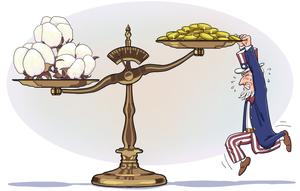 (JIN DING / CHINA DAILY)
(JIN DING / CHINA DAILY)
Some Western politicians and media consider the Xinjiang Uygur autonomous region a weak link in China's economy, and believe if they impose sanctions on its cotton industry-one of the three pillars of the region's economy along with oil and coal-they can strike at China's cotton and textile sector.
Yet the "boycott" of Xinjiang cotton by some foreign companies will only damage their brand image in China, disrupt the global supply chains, and increase cotton prices in the United States and some European countries.
China's import and export of primary products reached US$677.1 billion and US$115.5 billion respectively in 2020. And although China is the third-largest cotton producer in the world, it has been the leading cotton importing country for years, with the import volume increasing from 1.16 million tons in 2016 to 2.16 million tons in 2020. True, China also exports cotton, but its export volume is a fraction of its total imports. As for China's cotton consumption, it was 8.02 million tons in 2020, of which Xinjiang cotton accounted for 64 percent.
The main drawback of China's cotton industry is the imbalance between supply and demand, with the shortfall being made up by exports for years. China produced 5.95 million tons of cotton in 2020 while its total demand was 7.8 million tons, which means a shortfall of 1.85 million tons. And the fact that Xinjiang produces 87 percent of the cotton in China but meets only 64 percent of the domestic demand suggests that, if banned by some Western countries, the rest of the 23 percent of Xinjiang cotton could be easily consumed within the country's borders.
The ban on Xinjiang cotton is aimed at halting the exports of Chinese-made textiles and footwear, leading to the shifting of the manufacturing chains from China.
Better Cotton Initiative, an NGO headquartered in Switzerland, has initiated the "boycotting" of Xinjiang cotton based on false allegations of forced labor to undermine China's cotton and textile industry, which it has no right to do, because only a sovereign state is entitled to take enforcement measures against another sovereign state.
Some countries have imposed sanctions on some Chinese officials and entities in the name of so-called forced labor in Xinjiang. And the US has banned the import of cotton and cotton products from Xinjiang and added some Xinjiang enterprises to its Entity List.
Yet Western countries, companies and NGOs will never succeed in destroying China's cotton and textile industry by banning cotton and textile imports, because China can adjust the supply chains by encouraging cotton growers in Xinjiang and textile manufactures to sell their products in domestic or other foreign markets, while continuing to export cotton produced outside Xinjiang to the US. This may cause some problems for Chinese companies, but China can overcome those problems.
China's clothing and related industries have provided jobs to millions of people and increased the country's overall exports. Although China has been the largest exporter of textile products for decades, its clothing industry is facing rising labor and land costs. But the fact that the export of textile products reached 1.07 trillion yuan (US$162.88 billion) in 2020, up 30.4 percent year-on-year, shows the sector's resilience and competitiveness.
China's export of textiles and apparel to the US has declined in recent years-the US accounted for about 17 percent of China's textile and apparel exports in 2019 but the figure dropped to about 15 percent in 2020.
As long as China maintains social stability, some countries' sanctions against Xinjiang cotton will have little effect on the Chinese economy. And though some countries and regions may follow the US' lead and take similar action, they cannot cause much damage to China's cotton and textile industry, because, according to the US Department of Agriculture's monthly Cotton and Wool Outlook, released on March 11, both cotton production and consumption in China are expected to grow this year with improved yield in Xinjiang.
The US Agriculture Department also released a cotton outlook on Feb 19, saying China's 2020-21 cotton production is expected to reach 29 million bales, up nearly 2 million bales year-on-year, the highest in six years. In specific terms, China's cotton yield is estimated to reach a record 1,943 kilograms per hectare, up 13 percent year-on-year.
A similar situation happened last year when China started exporting medicines and equipment to help other countries to contain the spread of the novel coronavirus.
But despite some countries' desperate attempts to smear China, the country became the world's biggest supplier of anti-pandemic materials, shipping 438.5 billion yuan worth of materials to more than 200 countries and regions from March to December 2020, according to foreign trade data released by the General Administration of Customs in January.
Given these facts, the evil design to strike at China's cotton and textile industry is doomed to failure.
The author is a researcher at the Chinese Academy of International Trade and Economic Cooperation.
The views don't necessarily represent those of China Daily.



